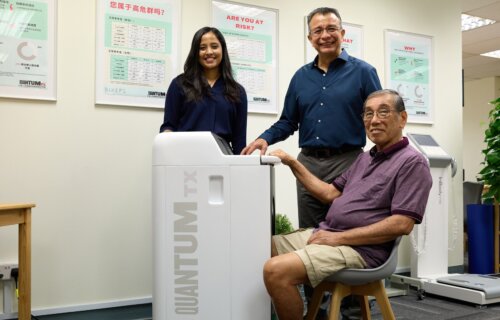SINGAPORE — Getting magnetic muscle therapy once a week can delay any age-related losses in muscle strength, according to a new trial in Singapore. After 12 weeks, older adults also saw their functional mobility improve and their body fat decrease.
The study authors recruited 101 participants between 38 to 91 years-old who participated in weekly exposure to low levels of proprietary pulsed electromagnetic field (PEMF) as part of their muscle therapy. The BIXEPS device was invented in 2019 and targets muscles in a person’s leg with a specific magnetic signature and creates metabolic activity in the cells, similar to when a person works out. Previous research showed people undergoing magnetic muscle therapy on one leg after knee surgery had improved whole body metabolism.
In this current study, people regained their muscle strength, enjoyed improved mobility, and reported less pain in their bodies after three months.
“We are very encouraged by the positive results of this community trial. PEMF-associated improvements were experienced by 85% of participants, irrespective of age, with the greatest benefits reported in older and more frail participants,” says Alfredo Franco-Obregón from the National University of Singapore in a media release. “Our findings suggest that PEMF therapy can produce comparable results to exercise in older persons and therefore holds potential therapeutic value for the older adult population.”

The entire study trial was completed in 34 months, from Jan. 1, 2020 to Oct. 31, 2022. Eighty-seven percent of participants had a pre-existing mobility dysfunction. The therapy was delivered for 10 minutes once a week on alternate legs for 12 weeks. To see if the treatment worked, each person underwent several performance tests and self-reported their pain levels starting from week 1 to week 12.
After eight weeks of treatment, 72 percent of the individuals showed improvements in their skeletal muscle maintenance along with decreases in total and visceral fats. Visceral fat is “bad fat” that is both harder to get rid of and linked to a number of metabolic disorders, including diabetes.
In total, 85 percent of the group had better functional mobility after 12 weeks, with the greatest improvements appearing in older study participants.
“Prior to the BIXEPS program, I had a lot of weakness in my legs. It was painful in my hip and feet when I took even a few steps. I could not climb the stairs the normal way, and had to rely on the handrails to balance myself,” recalls 79-year-old retiree George Teo. “At the end of 12 sessions, I felt that my leg movement had returned to normal, and I could go up and down the stairs without using the handrails.”
The research team is currently in talks with scientists in the U.S. and China on extending the trials to other countries.
You might also be interested in:
- An apple a day keeps frailty away, study shows
- Exercising as a child can prevent muscle weakening condition during old age
- Best Whey Protein: Top 5 Muscle-Building Powders Most Recommended By Experts
The study is published in the journal Aging.

